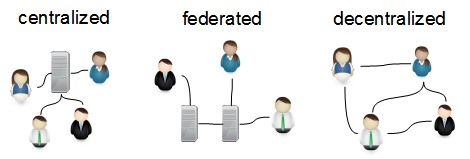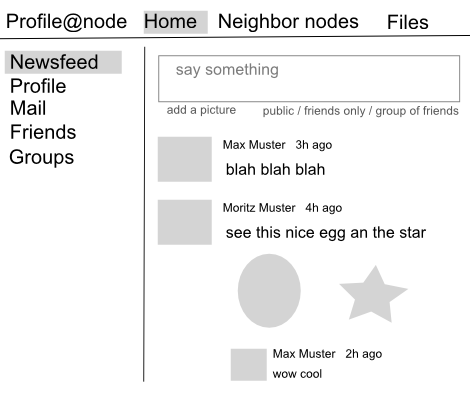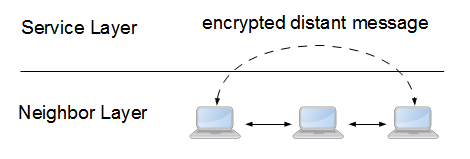During Google Summer of Code i did these things:
– learn what users expect from a social network. Figure out who should receive which messages.
– map social network functions on the existing Retroshare General Exchange System
– build a backend with basic features
– build a frontend with basic features
– started a new programming interface on top of libretroshare: a JSON over http interface
The Secushare homepage says: “RetroShare should provide more social functionality” Indeed! Every country is spying on their citizens. Storage, computing power and bandwidth became cheap. These are good conditions to build a distributed social network. The first step was already started a while ago with the General Exchange System for Retroshare v0.6. This project is the second step in this direction. One thing is missing: a release for normal users.
The backend and frontend made during GSoC can display a wall with avatar image and profile text. It is possible to create posts and reference them on walls. Posts can be commented. Read more details in the previous blog post. Still it is not suitable for daily use. There was not enough time to implement a scalable user interface architecture. The web interface can’t handle more than 100 posts, because pagination is missing. Whats more the UI is filled iterative. This causes many updates to the html tree with high cpu load. It would be better to send all information to the browser in one piece. The browser would then only have to update the HTML tree once. The design and layout should be improved to highlight the content and to get the date label out the way. (See the this screenshot.)
Future
Wt is nice because it allows to make a web interface without touching HTML JavaScript and CSS. But this is only the half truth. There where issues:
– completely destroyed layout by setting the image size
– menu bar was horizontal instead of vertical, this required to manual set a style class from C++
– WTimer stops working. I had to build my own server side timer
These issues where solvable. A real pain with Wt is the layout and UI design testing. You first have to go through the complete compile and start cycle to see changes. What if you missed a closing tag in a HTML template? You have to recompile and restart. Now i saw that with real web technologies you can see a live preview while you type. I think when doing layout and design it is important to immediately see the result. This is not possible with Wt. Conclusion: you can build a web interface with C++. But hard coding CSS class names and embedding HTML snippets in C++ is a pain that should be avoided.
On the other hand there exist advanced tools and frameworks for web development. AngularJS is a very nice JavaScript library. It offers data binding from JavaScript to HTML: you update a JavaScript object, and Angular updates the HTML. JavaScript objects are more flexible than C++ objects. You can even make a JavaScript object out of a JSON file. Angular makes handling of button clicks easy. AngularJS makes Bootstrap offers a set of widgets with HTML example code and style sheets. Now i want to use other web frameworks instead of Wt.
I did not know about these web technologies when starting the project. This is some sort of a chicken-egg problem: Retroshare does not have web developers, because it doesn’t have a web interface. And there will be no web interface until a web developer can show how it can be done. Gladly there is now a web developer who can teach me how to make a web interface.
The new idea: make a web interface using web technologies
The next goal is to make a clean and easy to use JSON over HTTP api for Retroshare. Then web developers are free to make a nice web interface using their favorite frameworks. This api is not only useful for web interfaces, but also for scripting. You could then send a chat message from a shell script using curl:
curl -X PUT -d ‘{“msg”:”hi all<br/>(send from bash)”}’ http://localhost:9090/api/chatlobbies/<id>
What i will do now
I will do more research for a JSON over HTTP interface for Retroshare and rssocialnet. If this stays a good idea i want to implements it. Maybe i will try to start a new web interface. But i hope someone else is faster than me. I prefer to work on the rssocialnet backend and libretroshare. Whats more a web interface is a perfect place for new contributors. If i would make a clearly documented JSON over HTTP api, then a web developer would not need C++ knowledge or experience with libretroshare.
A dream is to bring Retroshare to Android. This is possible, but we have to make a new touch-friendly user interface and we have to optimize Retroshare to make it more battery friendly. I currently see two ways to build a GUI for Android: with QML/QtQuick or HTML based with the Ionic Framework. There is already a QML prototype.
To get rssocialnet ready for daily use, i need your help. Unfortunately I’m again in a research/planning phase. This means I’m not sure how the JSON over HTTP interface will look at the end. It also means if you tell me “i want to help coding”, i have to disappoint you because i don’t know what we have to code and how to code it. Anyway, here are some things you can think about:
– which features are important for a social network? read some ideas
– can you make a better gui mockup than me?
– which frontend technologie should be used? QML/QtQuick or Bootstrap and AngularJS?
– what are the requirements for a first release?
– how can you use your skills to help?
Thank you Freifunk and other mesh network communities for donating one GSoC slot to Retroshare. This was a good decision, it made it possible to start a mesh friendly social network application.





